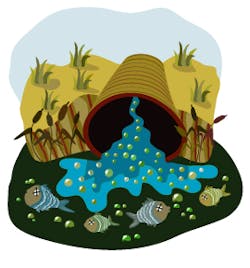Questions of Responsibility: Whose Pollutants?
A recent US Supreme Court decision in a case dealing with air pollution may have some interesting implications for water quality as well. In April, the Supreme Court overturned a lower court’s decision in EPA v. EME Homer City Generation, ruling 6-2 in support of EPA. The case deals with air pollution that crosses state borders, and the ruling affects several states that contain a large number of coal-fired electric plants.
There has been an ongoing battle between “upwind” states where emissions are generated and “downwind” states where the emissions end up. As things have stood, a state like Connecticut, even if it generated no air pollution at all within its borders, might still fail to meet air-quality standards mandated by the Clean Air Act simply because of the pollutants-carbon dioxide, sulfur dioxide, nitrogen oxide, and mercury-generated by its neighbors.
EPA has been trying for a couple of years to take measures to protect the downwind states but was challenged in court by a coalition of upwind states and industry representatives. This new ruling means the agency can impose stricter emissions standards on the upwind states, thus helping the downwind states to meet their own air-quality standards.
All this is a bit reminiscent of recent court cases involving water quality, such as last year’s Los Angeles County Flood Control District v. Natural Resources Defense Council, but with a very different outcome. In that case, Los Angeles County argued that it should not be held responsible for polluted runoff discharging to the Pacific Ocean from two of its waterways, the Los Angeles and San Gabriel rivers, because most of the pollutants came from upstream sources outside the county’s jurisdiction and control. However, the case was ultimately decided in favor of the environmental groups that sued to hold the county accountable for the pollutants. This is surely not the last time we’ll see a water-quality case of this kind, though, and it will be interesting to see whether the decision in EPA v. EME Homer City Generation will have any bearing on future cases involving water-borne pollutants.
Closer to home for those who deal with soils, the Supreme Court’s April decision might have some future implications for regulating airborne dust as well. This issue has already been debated on a small scale, with cities and counties complaining about dust from construction activities in nearby jurisdictions, as well as in the international arena, with countries like South Korea and Japan objecting to air pollution originating in China. Based on this new precedent, might states with more construction activities or drier climates find themselves facing even stricter air-quality standards?
Another complex question-whether dealing with air or water pollution-involves tracing sources and assigning responsibility. As Justice Ginsburg noted in the majority opinion in the air-quality case, some states “export” air pollutants to more than one neighboring state, some receive pollutants from more than one state, and some both send and receive. There are several possible approaches to remedy the problem, including taking into account what each state has already done to curb pollution. Some have argued that emissions reductions should be strictly proportional to each state’s share of responsibility for the pollution it’s sending downwind, but the Supreme Court allowed that other options exist, including more strictly regulating states that have taken fewer pollution-control measures in the past.
Do you agree or disagree with the Supreme Court’s recent decision-and do you think it might affect future dust control or water-quality cases? Leave a comment below.
About the Author
Janice Kaspersen
Janice Kaspersen is the former editor of Erosion Control and Stormwater magazines.


